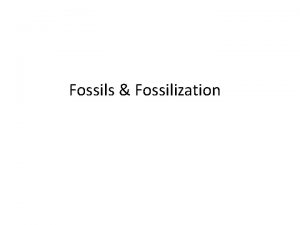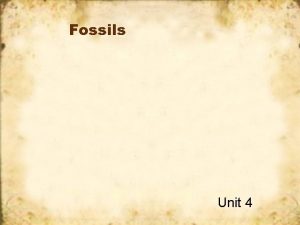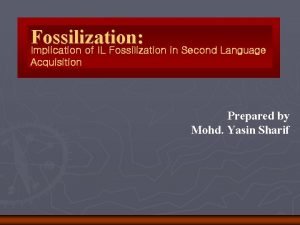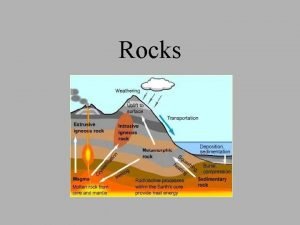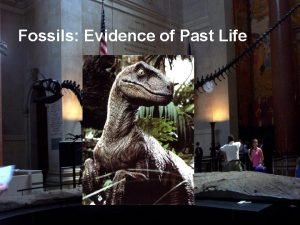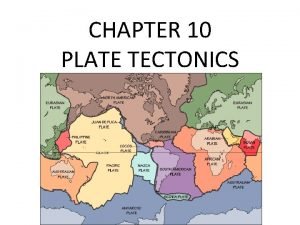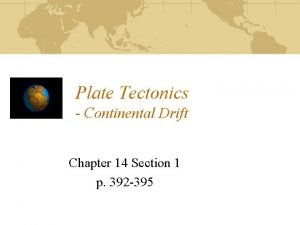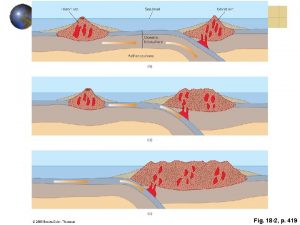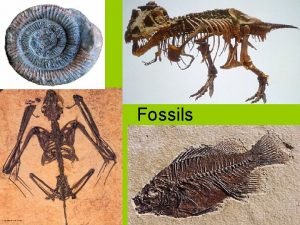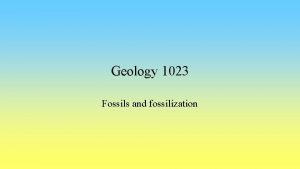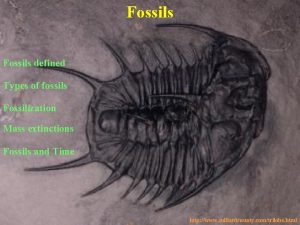Fossils Fossilization Preservation Unaltered Soft Parts 1 Remains










- Slides: 10

Fossils & Fossilization

Preservation- Unaltered Soft Parts 1. Remains of mammoth and rhinoceroses in frozen tundras of Siberia and North America. 2. Insect exoskeletons and minute appendages have been preserved in amber, the hardened resin of ancient coniferous trees. 3. In Poland an Ice Age wooly rhinoceros was well preserved in asphalt and the La Brea Tar Pits of Los Angeles contain many Pleistocene animals. 4. In semi-arid South America, parts of mummified ground sloths have been preserved in caves. 6. Algae and bacteria have been reported preserved in Precambrian chert (Chert is a microcrystalline sedimentary rock material composed of silicon dioxide ).


Preservation- Unaltered Hard Parts 1. Calcite (Ca. CO 3 is the most abundant original skeletal material found in fossils 2. Aragonite (Ca. CO 3) is preserved in the shells of some corals and molluscs. Rare in late Paleozoic fossils, absent from older ones, since aragonite tends to invert into the more stable calcite or dissolves. 3. Tricalcium Phosphate (Ca 3(PO 4)2) is a chemically resistant mineral found unaltered in vertebrate bones, some arthropods and brachiopods. 4. Opal (Si. O 2 H 2 O) is an amorphous hydrated silica preserved in latter geologic time in some Protozoans and sponges. It is unstable. 5. Chitin is an organic compound that is resistant to bacterial action and is not readily altered. It is found in many arthropods and graptolites


Permineralization • (Petrification) process whereby porous skeletons are made denser and heavier by precipitation of minerals by ground water in the open spaces or pores of the skeletons. E. g. calcite, silica and glauconite

Recrystalization • Refers to the process whereby the shell material undergoes reorganization that partly or completely destroys the original microstructure • This is a common phenomenon in shells which were originally aragonite and/or calcite (both forms of calcium carbonate- Ca. CO 3). – Examples, both of which are now calcite, include a gastropod which was originally aragonite and a brachiopod which was originally calcite


Replacement • Refers to mineral substances being substituted for the hard parts (sometimes even soft part) of organisms, probably by simultaneous solution and precipitation. – – – Pyrite (Fe. S 2) frequently replaces shells: pyritization. Calcite may replace silica, calcite and aragonite: calcification. Dolomite (Ca. Mg(CO 3)2) may replace calcite or aragonite shells: dolomitization. Replacement may be done by iron minerals such as hematite or limonite. Silica (chalcedony and quartz) commonly replaces calcareous skeletons: silicification. Other carbonates (siderite, rhodochrosite) may also replace shells, though less commonly: calcification.

Carbonization • Involves a decrease in volatile constituents of tissues and chitin such as hydrogen, oxygen and nitrogen, leaving a thin film of carbon. E. g. graptolites, plant remains
 Unaltered hard parts
Unaltered hard parts How are unaltered fossils formed
How are unaltered fossils formed Types of fossils
Types of fossils Site:slidetodoc.com
Site:slidetodoc.com Fossils in rocks
Fossils in rocks Fossils evidence of past life
Fossils evidence of past life Best index fossil
Best index fossil There are no transitional fossils fact, fiction or opinion
There are no transitional fossils fact, fiction or opinion Chapter 10 plate tectonics
Chapter 10 plate tectonics Similar fossils found on different continents
Similar fossils found on different continents Glacial evidence of pangea
Glacial evidence of pangea
